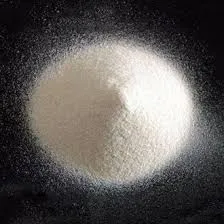
Dic . 14, 2024 14:20 Back to list
Understanding the Structure and Properties of Hydroxyethyl Cellulose in Various Applications
Understanding the Structure and Applications of Hydroxyethyl Cellulose
Hydroxyethyl cellulose (HEC) is a cellulose derivative that has gained substantial attention in various fields due to its unique chemical structure and versatile properties. As a water-soluble polymer, HEC is widely used in industries such as pharmaceuticals, cosmetics, food, and construction due to its excellent thickening, gelling, and film-forming abilities.
Chemical Structure of Hydroxyethyl Cellulose
The basic structure of cellulose consists of a linear chain of D-glucose units linked by β-1,4-glycosidic bonds. Hydroxyethyl cellulose is produced by the partial substitution of the hydroxyl groups of cellulose with hydroxyethyl groups. This modification enhances the solubility of cellulose in water without significantly altering its fibrous structure.
In terms of its chemical formula, the modification introduces hydroxyethyl groups (—CH2CH2OH) into the cellulose backbone. This process involves the ethylene oxide reaction with cellulose, resulting in a polymer chain that retains its cellulose characteristics while exhibiting additional properties due to the new functional groups. The degree of substitution and the molecular weight of the polymer can be controlled during the synthesis process, allowing for tailor-made properties suited to specific applications.
Properties of Hydroxyethyl Cellulose
One of the most notable properties of HEC is its ability to dissolve in cold water, forming a clear, viscous solution. This solubility is attributed to the presence of the hydroxyethyl groups, which disrupt the strong hydrogen-bonding network typical of cellulose. The viscosity of HEC solutions can vary significantly based on concentration, molecular weight, and temperature, making it a highly adaptable ingredient.
HEC is also non-ionic and chemically stable, providing compatibility with a wide range of other chemicals, including surfactants, electrolytes, and other polymers. This stability makes HEC an excellent thickening agent, emulsifier, and stabilizer in formulations. Additionally, it has film-forming properties, which makes it valuable in applications where a continuous film is desired.
hydroxyethyl cellulose structure

Applications of Hydroxyethyl Cellulose
1. Pharmaceuticals In the pharmaceutical industry, HEC is utilized as a binder, thickener, and stabilizer in various formulations, including oral, topical, and parenteral products. Its ability to form gels and control the release of active ingredients makes it a key ingredient in controlled-release formulations.
2. Cosmetics and Personal Care Products HEC is widely used in cosmetics, skin care, and hair care products due to its thickening and film-forming properties. It helps create stable emulsions in creams and lotions and improves the texture and sensory feel of products.
3. Food Industry In food applications, HEC acts as a thickener and stabilizer, enhancing the texture and consistency of sauces, dressings, and dairy products. Its ability to retain moisture also makes it useful in preventing syneresis in gel products.
4. Construction HEC is also employed in the construction industry, particularly in tile adhesives, mortar, and plaster. It helps improve workability, adhesion, and water retention of the materials, ensuring better performance and durability.
5. Agriculture In agriculture, HEC is used as a coating agent for granular fertilizers and pesticides, aiding in the controlled release of nutrients and improving soil moisture retention.
Conclusion
The unique structure and properties of hydroxyethyl cellulose make it an invaluable component across various industries. Its water-soluble nature, combined with the ability to be chemically modified, allows for extensive customizability for specific applications. As research continues to uncover new uses for HEC, its significance is likely to grow, further cementing its role as an essential ingredient in modern formulations and products. Whether in pharmaceuticals, cosmetics, food, or construction materials, hydroxyethyl cellulose demonstrates the profound impact that polymers can have on technology and daily life.
-
Versatile Hpmc Uses in Different Industries
NewsJun.19,2025
-
Redispersible Powder's Role in Enhancing Durability of Construction Products
NewsJun.19,2025
-
Hydroxyethyl Cellulose Applications Driving Green Industrial Processes
NewsJun.19,2025
-
Exploring Different Redispersible Polymer Powder
NewsJun.19,2025
-
Choosing the Right Mortar Bonding Agent
NewsJun.19,2025
-
Applications and Significance of China Hpmc in Modern Industries
NewsJun.19,2025







